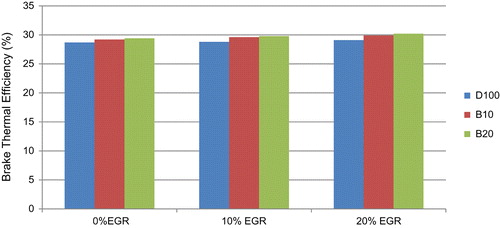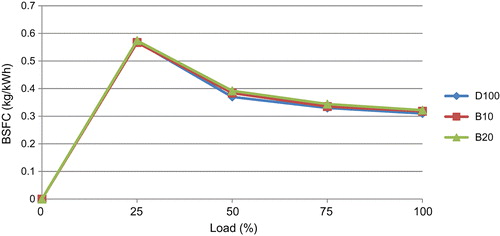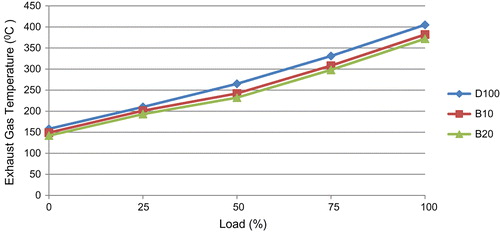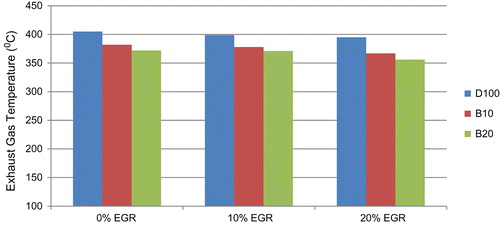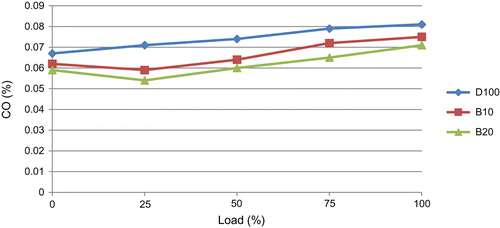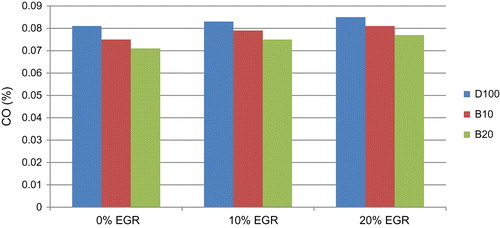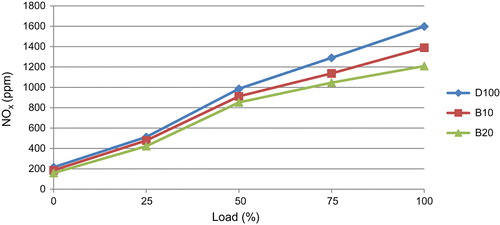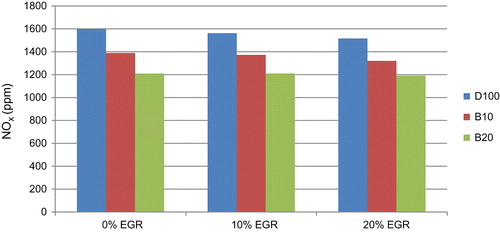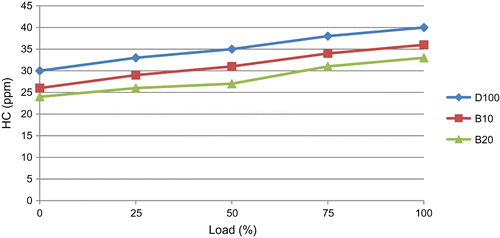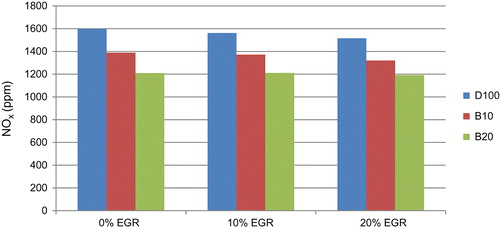Abstract
In this study, balanites Aegyptiaca (L.) Del biodiesel was blended in proportions of 10% and 20% on the volume basis with diesel fuel and tested in a single cylinder, VCR diesel engine under measured load conditions with varied EGR rates (0, 10 and 20%). The results showed that B10 and B20 blends shown a significant reduction rate in terms of NOx emissions that were familiar with biodiesel blends. At peak load conditions, BTE increased slightly for test fuel blends compared with pure diesel fuel while the BSFC rate and EGT suffered from increasing and decreasing nature with respect to blending percentage. From the emissions point of view, with the increase in blends percentage, a significant reduction rate is observed in terms of CO and HC concentrations (up to 12.34 and 17.5%, respectively) while NOx emissions decreased at peak load conditions (up to 24.34%). HC and CO emissions decreased with increase in blends percentage. However, lower levels of NOx and EGT (up to 21.37 and 8.47%, respectively) and the average increase in terms of BTE and BSFC (up to 2.83 and 2.9%, respectively) can be realised with B20 test fuel blend under 20% EGR rate.
1. Introduction
Due to fast depletion of fossil fuels and their increase in emission rates are the main key factors to look for an alternate substitute. Biodiesel is a biodegradable and clean fuel extracted from vegetables and animal fats suits best substitute for diesel, although the physical properties of biodiesel resemble the similar properties compared with diesel fuel. Due to the existence of free oxygen atom in biodiesel, a significant reduction rate can be observed towards emission rates (Venkateswarlu, Murthy, and Subbarao Citation2015). Diesel engines are widely used as a power source for transportation due to its better performance parameters, maintenance, high compression ratio, high power output and its high thermal efficiency. However, diesel engines are the major source of air pollution due to HC and NOx emission rates. EGR is the effective technique used in order to control the NOx emissions (Subbarayan, and Senthil Kumaar Citation2015). Exhaust Gas Recirculation technique is a really constructive method in controlling NOx emission rate in diesel engines but the main limitation using this method at peak load conditions and at higher varied EGR rates this is due to combustion tends to deteriorate at peak load conditions resulting in poor performance and emission parameters. On the other hand, NOx emissions mostly influence the fuel consumption rate and also results in uncontrolled emission parameters in terms of HC, CO and PM. However, EGR technique effectively controls the NOx concentrations on one hand but resulting higher remaining emission rates (Rajan, and Senthilkumar Citation2009). The effects of varied EGR rate in proportions against biodiesel blends is a considerable modification required in order to minimise the nitrogen oxides (NOx) emissions that are common with biodiesel blends.
Many studies have been carried out with varied EGR rates and studied the performance, combustion and emission characteristics in a CI diesel engine with biodiesel blends and concluded their valuable suggestions. Subbarayan, and Senthil Kumaar (Citation2015) tested cottonseed biodiesel blends by cold and hot EGR rate with respect to injection pressure and injection timing and observed a significant increase in HC, smoke opacity and NOx emission rates. However, at varied load conditions, hot EGR rate showed lower emission behaviour compared with cold EGR. Rajan and Senthilkumar (Citation2009) evaluated the sunflower methyl ester in a twin cylinder DI CI diesel engine with varied EGR rates and reported that at 15% EGR rate B20 test fuel blend shown a significant reduction rate in terms of NOx emission rate compared with pure diesel fuel. Solaimuthu et al. (Citation2015) studied the performance of mahua biodiesel blends in a single cylinder diesel engine and reported that a controlled emission rate is observed which can be used as an alternate substitute to diesel fuel. Kumar et al. (Citation2015) carried out experiments in a VCR diesel engine using B10 and B20 pinnai oil test fuel blends and stated that the experimental evaluation of test fuel blends is effective relative to that of pure diesel fuel. Pali et al. (Citation2015) tested sal seed oil blends in proportions of 10, 20, 30 and 40% on the volume basis and concluded that a significant reduction behaviour is observed in terms of performance and emission parameters with respect to pure diesel fuel. Pradeep and Sharma (Citation2007) evaluated using jatropha biodiesel blends with and without EGR technique and reported that at 15% EGR rate a significant reduction rate in NO emissions is with controlled other emission parameters. Agrawal et al. (Citation2006) studied the NOx emissions rate in a twin cylinder DI diesel engine fuelled using EGR technique and found that a significant increase in CO and HC emission rates and also results in an increase in specific fuel consumption rate. Shehata and Abdel Razek (Citation2011) investigated using sunflower oil and jajoba oil in a direct injection engine and reported that a significant reduction behaviour in BTE and BP with a high BSFC rate at varied EGR rates. Saravanan (Citation2015) studied the effects of n-pentanol biodiesel blends (10, 20 and 30%) in a single cylinder DI CI engine at varied EGR rates and reported that a significant reduction in emission parameters is observed at varied EGR rate from 20 to 30% and also observed a slight reduction in terms of performance characteristics. Can et al. (Citation2016) tested B20 soybean biodiesel test fuel blend with varied EGR rates in proportions of 5, 10 and 15% EGR rates, respectively, and concluded that a significant increase is observed in consumption rate with a lower BTE value at 15% EGR rate. Hussain et al. (Citation2012) studied the performance of EGR in a three cylinder DI diesel engine and reported that the NOx rate and EGT are effectively controlled but with a significant increase in PM, CO and HC at varied EGR rate. Tsolakis et al., (Citation2007) tested rapeseed biodiesel blends with varied EGR rates and found that performance in terms of pre-combustion, delay period and HRR at early stage, whereas a significant increase in NOx emission rate is observed when compared with diesel fuel. Hountalas et al. (Citation2008) studied the effects of cold EGR rate in a turbocharged DI diesel engine with respect to varied EGR rates and reported that a significant reduction rate is observed in BTE, CP and soot particles at varied EGR rates.
The present study investigates the performance and emissions characteristics of test fuel blends from banalities aegyptiaca biodiesel blends on the volume basis i.e. BA10 (10% Banalities aegyptiaca biodiesel + 80% diesel), BA20 (20% Banalities aegyptiaca biodiesel + 80% diesel) and to compared with D100 (100% pure diesel fuel) at the same experimental conditions with varied EGR rates in proportions of 0, 10 and 20%, respectively.
1.1. Features of balanites aegyptiaca
Balanites aegyptiaca is an evergreen xerophytic plant widely distributed throughout the arid aegyptiaca have their own traditional medicinal properties (Varshney and Anis Citation2013). Besides that, the tree is ecologically very flexible with excellent persistence. It can withstand occasional flooding and is adaptable to a wide range of sites and climatic conditions. Also, this plant is well known for its non-medicinal importance like famine food, fodder, fuel wood, jewellery, chemical extract and detergent, etc., [15 regions of India and Asia. These species are known for their wide usability and various parts of Balanites]. The oil extracted from the Balanites aegyptiaca seed kernels is green, oxygenated, non-hazardous and restricted from sulphur and aromatics. The availability of oxygen atom in Balanites aegyptiaca oil (BAO) shows significant contributions towards nitrous emissions and moreover the oxygen content boosts for the better combustion process. Whereas the calorific value of BAO is much nearer to that of diesel and the viscosity of BAO is much higher compared with diesel fuel which is problematic while running in the engine. So by further esterification process, the viscosity level is lowered for effective running in engine (Deshmukh and Bhuyar Citation2009).
Besides its multipurpose nature of tree species, BAME shows higher nature towards NOx emissions compared with diesel oil due to the presence of oxygen atom in combustion process which increases further with the increase in blending proportions and the oxygen content also forces the above outcome. So, by transesterification process viscosity and density of BAO is reduced and much nearer to that of diesel.
Transesterification is a chemical process in which triglycerides are converted into its methyl esters with alcohol in the presence base catalyst for the better yield. Alkali catalyst like KOH is used to chemically modify Balanites aegyptiaca oil to Balanites aegyptiaca methyl ester (BAME) through the transesterification process (Gutti et al. Citation2012). Consequently extracted oil shows nearby properties to that of diesel fuel and better for engine running.
illustrates the physical properties of BAO in terms of flash point, density and specific gravity to that of pure diesel fuel.
Table 1. Properties of diesel and BAME.
1.2. EGR technique
Reasonably NOx reduction strategies are classified into pre-combustion (Addition of additives) and post-combustion (EGR technique). Based upon above modifications, test fuels are blended with additives for NOx reduction rate and the engine exhaust modification is required for minimising the NOx emissions. EGR technique is the most commonly known NOx emission controlling technique widely used in diesel engines fuelled with both diesel and biodiesel blends. Primarily NOx emission rate depends majorly upon cylinder temperature. The exhaust gases are recirculated to engine intake valve in order to increase the combustion behaviour of the mixture and to reduce the oxygen intake content which plays a vital role in the substantial reduction of NOx emissions. However, the major drawback of using EGR technique highlights in terms of higher BSFC and other emissions parameters. Emissions parameters like HC, CO and PM shows slightly higher concentration in addition to that of BSFC rate. Using EGR technique the air–fuel ratio increases the PM rate and the oxygen content decreased with the increase in load. Therefore, NOx reduction varies with engine load and high EGR rates are required at low loads and low EGR rates at high loads. Engine operating on biodiesel blends with varied EGR rate at different loading conditions results in NOx reductions without affecting the performance and emission characteristics (Agarwal et al. Citation2006).
However, based upon combustion characters pre-combustion and during combustion techniques greatly impact on the engine combustion characteristics, while post-combustion technique has no effect on the engine.
2. Experimental set-up and methodology
The present experimental study is carried out in a 3.7 kW single cylinder, four strokes, water cooled for the auxiliary head, direct injection VCR diesel engine running at different blending ratios. The physical properties of test fuels were shown below in . The engine is set for constant rpm at 1500 loaded with eddy current dynamometer and a screw rod arrangement with a hand wheel also provided. By controlling the hand wheel compression ratio is varied in engine running condition. Engine proportions are calculated while running on diesel and biodiesel. The selected scope of blending ratio of diesel and biodiesel are B10, B20 and D100. The detailed technical specifications of the engine are given below in . The control panel is instrumented with flow sensors in order to calculate the readings at different positions such a flow measurement, valve arrangement, water draining and silicon rope is insulated throughout exhaust pipe to minimise the heat loss. Brake power, BSFC, BTE and VE were measured with computer-based system calculations and combustion characteristics experiment for blending proportions with varying load. The exhaust emissions were measured at the exhaust valve by the gas analyser.
Table 2. Properties of test fuels.
Table 3. Specifications of test engine.
2.1. Transesterification process
Balanites aegyptiaca oil (BAO) is precise as feedstock for the biodiesel production. BAO was converted into its methyl esters through alkali-catalysed transesterification. It is a chemical process of converting triglyceride with alcohol in the presence of a base catalyst for the better yield. The optimum yield of BAO depends on upon the percentage of catalyst loadings on the weight basis, molar ratio, reaction time and temperature, respectively. The physical properties of diesel, BAO, BAME are tabulated in .
Table 4. Fuel properties.
3. Experimental results
Experimental study of engine performance parameters and emission characteristics, of a single cylinder, water cooled, direct injection VCR diesel engine at different engine loads at constant engine speed have been performed. The engine is performed with D100 in comparison with the blending ratio of B10 and B20. The outcome of this research gives the effect of EGR on performance and emission characteristics. The various parameters are described in detail below ().
Table 5. Comparison of BAME properties with various biodiesel standards before blending.
3.1. Performance analysis
3.1.1. Brake thermal efficiency (BTE)
shows the variation of BTE for the test fuels D100, B10 and B20 with respect to measured load conditions without using EGR technique. At each interval, the test fuel blends had higher BTE values than that of pure diesel fuel. The results showed that the B10 and B20 test fuel blends exhibited a significant increase in 1.7 and 2.3%, respectively compared with D100 at peak load conditions. It can be attributed due to the existence of oxygen atom, which boosted the combustion behaviour inside the combustion chamber. Hence, B20 test fuel blend performed better combustion behaviour at high load conditions ().
Table 6. Performance and emission characteristics of D100 and BAME blends at full load.
shows the effects of varied EGR rates with respect to BTE at peak load conditions for the test fuel blends D100, B10 and B20, respectively. It can be observed that a significant increase in BTE for B10 and B20 blends with respect to D100 at varied EGR rates. The average percentage variation of BTE for B10 and B20 blends compared to that of D100 at varied EGR rates in proportions of 0, 10 and 20% are about 2.045, 3.025 and 2.83%, respectively.
3.1.2. Brake specific fuel consumption (BSFC)
illustrates the variation of BSFC as a function of measured load conditions for the test fuels without using EGR technique. Biodiesel blends showed higher BSFC rate than that of pure diesel fuel. The pure diesel fuel D100 exhibited a significant reduction in terms of BSFC values over B10 and B20. The fuel consumption rate for the B10 and B20 test fuel blends are about 2.51 and 3.72% higher compared to that of D100 at peak load conditions. The relatively higher BSFC rate of B10 and B20 blends compared with D100 was due to the increase in ignition behaviour caused by the existence of oxygen in its atomic structure. Biodiesel blends B10 and B20 exhibited higher viscosity and density than pure diesel fuel, thus resulting in incomplete combustion inside the cylinder, due to high viscosity nature the fuel spray behaviour direct to improper atomisation.
The effects of varied EGR rates with respect to BSFC rate for the test fuel blends at peak load conditions are shown in . In general, higher BSFC rate is observed for blends B10 and B20 compared to that of D100 is due to low CV of biodiesel blends but the blends resulted in a significant reduction rate in terms of fuel consumption with varied EGR rates. The average reduction of BSFC for B10 and B20 blends, contrast to that of D100 at varied EGR rates 0, 10 and 20% are 3.12, 2.21 and 2.905%, respectively. Moreover, a significant reduction rate was observed using EGR technique.
3.1.3. Exhaust gas temperature (EGT)
illustrates the variation of EGT of test fuel blends D100, B10 and B20 within measured load conditions without using EGR technique and shown that a significant reduction behaviour is observed using B10 and B20 blends with respect to pure diesel fuel D100. The EGT of B10 and B20 blends exhibited a significant temperature reduction behaviour of 5.67 and 8.14%, respectively with respect to D100. The lower value of EGT for biodiesel blends was due to incomplete combustion process carried inside the cylinder using B10 and B20 biodiesel blends results in significant low energy content at measured load conditions.
The effects of varied EGT rates for the test fuels D100, B10 and B20 as a function of measured load conditions are shown in . The results showed that B10 and B20 blends exhibited significant reduction behaviour with varied EGR rates compared with D100 at peak load conditions. This is may be due to higher latent of vaporisation of test fuel blends as well as reduction behaviour in peak cylinder temperature reduces the EGT value with varied EGR rates. The average temperature reduction rate of blends B10 and B20 relative to that of D100 at 0, 10 and 20% EGR rates are about 6.9, 6.135 and 5.83%, respectively.
3.2. Emission analysis
3.2.1. CO emissions
The CO emission rate against the measured load conditions for test fuels D100, B10 and B20 without using EGR technique is shown in above . The rate of increase in blending percentage lowers the CO emission rate with measured load conditions. The results showed that B10 and B20 blends shown a significant reduction rate of CO emissions compared with D100 at high load conditions. The oxygenated test fuel blends B10 and B20 showed a significant reduction behaviour of approximately 7.4 and 12.34% in difference with D100, respectively. This can be due to decreasing the value of cylinder temperature in the chamber which results in pre-formation of CO emissions.
The effects of varied EGR rates in proportions of 0, 10 and 20% with respect to CO emission rate for all test fuels at peak load conditions are plotted in . It is apparent that with varied EGR rates a significant reduction behaviour is observed in terms of CO emissions rate due to the slight convenience of oxygen atom. As a result, a significant increase in CO emission rate is observed with varied proportions of EGR rates. The average B10 and B20 test fuel blends behaviour in terms of CO emission rate at varied proportions of EGR rates 0, 10 and 20% is about 9.87, 7.06 and 7.05%, respectively, relative to that of D100.
3.2.2. NOx emissions
illustrates the variation of NOx emissions with respect to measured load conditions for the test fuel blends with 0% EGR rate. From the above Figure, it can be seen that maximum NOx emission rate for test fuel blends (B10 and B20) showed a significant reduction behaviour compared with pure diesel fuel D100. The NOx emission rate of test fuel blends B10 and B20 shown a significant reduction rate of up to 12.58 and 23.91%, respectively, compared with D100 at peak load conditions. This can be attributed to blends nature towards lower cetane No. which results in longer delay period.
The effects of varied EGR rates with respect to NOx emissions rate in proportions of 0, 10 and 20% for the test fuels at peak load conditions are shown in . It is observed that a significant reduction behaviour in terms of NOx emission rate with respect to varied EGR rates. This can be accredited due to the lack of oxygen atom which further results in retarded combustion behaviour as well as the flame temperature inside the combustion chamber. The average NOx emission reduction rate of test fuel blends B10 and B20 at 0, 10 and 20% varied EGR rates are about 18.24, 17.67 and 17.14%, respectively, compared to that of D100 fuel.
3.2.3. HC emissions
The discrepancy of HC emission rate with respect to measured load conditions without using EGR technique are shown in for different test fuels at optimum load conditions. In general, a significant reduction behaviour is observed using test fuel blends B10 and B20 due to enhanced combustion efficiency in terms of HC emissions compared with varied blends percentage. Whereas, the B10 and B20 test fuel blends exhibited a significant reduction in terms of HC emission rate values over D100. Their reduction in terms of HC emission rate for test fuel blends B10 and B20 was approximately varied to 10 and 17.5% variation compared with D100, respectively. This may be attributed due to higher cetane value, D100 exhibits higher emission rate compared to that of B10 and B20 blends which in return supports cooling atmosphere behaviour inside the cylinder which reduces the HC emission rate.
The effects of varied EGR rates in proportions of 0, 10 and 20% with respect to HC emission rate for the test fuels at optimum load conditions are plotted in . From the above figure, it can be observed that the significant reduction rate of HC emission rates relative to that the varied EGR rate for blends B10 and B20 is due to improper combustion behaviour inside the combustion chamber. The average reduction percentage of HC emission rates for blends B10 and B20 in proportions of 0, 10 and 20% EGR rate are about 13.75, 14.1 and 11.25%, respectively, compared with D100.
4. Conclusions
The main aim of the study is to evaluate the performance of B10 and B20 biodiesel blends with varied EGR rates. The following conclusions drawn are as follows: A significant increase in BTE up to 2.83% with a reduction rate of BSFC of up to 2.9% on average is observed with increase in blend percentage. Whereas, on the other hand EGT shown a significant reduction rate of up to 8.47% on average was achieved using 20% EGR with B10 and B20 test fuel blends. In case of emission parameters, CO, HC and NOx emission rates showed a significant reduction rate of 12.34, 17.5 and 21.37%, respectively, with B20 test fuel blend at peak load conditions.
| Acronyms and abbreviations | ||
| VCR | = | Variable Compression Ratio |
| EGR | = | Exhaust Gas Recirculation |
| NOx | = | Nitric oxides |
| HC | = | Hydrocarbon |
| CO | = | Carbon Monoxide |
| PM | = | Particulate Matter |
| SME | = | Sal Methyl Ester |
| BTE | = | Brake Thermal Efficiency |
| BSEC | = | Brake Specific Energy Consumption |
| BAME | = | Balanites Aegyptiaca Methyl Ester |
| BAO | = | Balanites Aegyptiaca Oil |
| VE | = | Volumetric Efficiency |
| CFPP | = | Cold Filter Plug Point |
| BSFC | = | Brake Specific Fuel Consumption |
| EGT | = | Exhaust Gas Temperature |
Disclosure statement
No potential conflict of interest was reported by the authors.
Funding
This work was supported by the University college of Engineering, Kakinada, JNTUK KAKINADA under [grant number Procs.No.TEQIP-II/Mech/R&D/Academics/SC 1.2–3(v)/2015–16].
Notes on contributors
N. Sunil Naik , (PhD), works as a Full time research scholar at Jawaharlal Nehru Technological University, Kakinada, Andhra Pradesh, India. His main research interests are in Internal Combustion Engines and Alternate Fuels and Biodiesel production. Previous publications have appeared in Biofuels, International Journal of Ambient Energy, and others.
B. Balakrishna , PhD, is a professor of Mechanical Engineering at the Jawaharlal Nehru Technological University, Kakinada, and the Vice principal (Academics) of the College. His research interests include in Internal Combustion Engines and Alternate Fuels and Biodiesel production. Previous publications Journal of Manufacturing Technology Today, Journal of the Brazilian Society of Mechanical Sciences and Engineering, 21 publications have appeared in the Biofuels, International Journal of Ambient Energy, and others.
References
- Agarwal, Deepak, Shailendra Sinha, and Avinash Kumar Agarwal. 2006. “Experimental Investigation of Control of NOx Emissions in Biodiesel-fueled Compression Ignition Engine.” Renewable Energy 31 (14): 2356–2369.10.1016/j.renene.2005.12.003
- Can, Ozer, Erkan Ozturk, Hamit Solmaz, Fatih Aksoy, Can Çinar, and H. Serdar Yucesu. 2016. “Combined Effects of Soybean Biodiesel Fuel Addition and EGR Application on the Combustion and Exhaust Emissions in a Diesel Engine.” Applied Thermal Engineering 95: 115–124.10.1016/j.applthermaleng.2015.11.056
- Deshmukh, S. J., and L. B. Bhuyar. 2009. “Transesterified Hingan (Balanites) Oil as a Fuel for Compression Ignition Engines.” Biomass and Bioenergy 33 (1): 108–112.10.1016/j.biombioe.2008.04.017
- Gutti, Babagana, Shittu S. Bamidele, and Idris M. Bugaje. 2012. “Biodiesel Kinematics Viscosity Analysis of Balanite Aegyptiaca Seed Oil.” ARPN Journal of Engineering and Applied Sciences 4: 432–435.
- Hountalas, D. T., G. C. Mavropoulos, and K. B. Binder. 2008. “Effect of Exhaust Gas Recirculation (EGR) Temperature for Various EGR Rates on Heavy Duty DI Diesel Engine Performance and Emissions.” Energy 33 (2): 272–283.10.1016/j.energy.2007.07.002
- Hussain, J., K. Palaniradja, N. Alagumurthi, and R. Manimaran. 2012. “Retracted: Effect of Exhaust Gas Recirculation (EGR) on Performance and Emission Characteristics of a Three Cylinder Direct Injection Compression Ignition Engine.” Alexandria Engineering Journal 51 (4): 241–247.10.1016/j.aej.2012.09.004
- Kumar, T. Ashok, R. Chandramouli, and T. Mohanraj. 2015. “A Study on the Performance and Emission Characteristics of Esterified Pinnai Oil Tested in VCR Engine.” Ecotoxicology and Environmental Safety 121: 51–56.10.1016/j.ecoenv.2015.06.008
- Pali, Harveer S., N. Kumar, and Y. Alhassan. 2015. “Performance and Emission Characteristics of an Agricultural Diesel Engine Fueled with Blends of Sal Methyl Esters and Diesel.” Energy Conversion and Management 90: 146–153.10.1016/j.enconman.2014.10.064
- Pradeep, V., and R. P. Sharma. 2007. “Use of HOT EGR for NOx Control in a Compression Ignition Engine Fuelled with Bio-diesel from Jatropha Oil.” Renewable Energy 32 (7): 1136–1154.10.1016/j.renene.2006.04.017
- Rajan, K., and K. R. Senthilkumar. 2009. “Effect of Exhaust Gas Recirculation (EGR) on the Performance and Emission Characteristics of Diesel Engine with Sunflower Oil Methyl Ester.” Jordan Journal of Mechanical and Industrial Engineering 3 (4): 306–311.
- Saravanan, S. 2015. “Effect of Exhaust Gas Recirculation (EGR) on Performance and Emissions of a Constant Speed DI Diesel Engine Fueled with Pentanol/Diesel Blends.” Fuel 160: 217–226.
- Shehata, M. S., and S. M. Abdel Razek. 2011. “Experimental Investigation of Diesel Engine Performance and Emission Characteristics Using Jojoba/Diesel Blend and Sunflower Oil.” Fuel 90 (2): 886–897.10.1016/j.fuel.2010.09.011
- Solaimuthu, C., V. Ganesan, D. Senthilkumar, and K. K. Ramasamy. 2015. “Emission Reductions Studies of a Biodiesel Engine Using EGR and SCR for Agriculture Operations in Developing Countries.” Applied Energy 138: 91–98.10.1016/j.apenergy.2014.04.023
- Subbarayan, M. R., and J. S. Senthil Kumaar. 2015. “An Experimental Investigation of Performance and Emission Characteristics of Diesel Engine with Blends of Cottonseed Oil Methyl Ester with Cold and Hot EGR.” International Journal of Ambient Energy 38 (1): 19–28. doi:10.1080/01430750.2015.1023844.
- Tsolakis, A., A. Megaritis, M. L. Wyszynski, and K. Theinnoi. 2007. “Engine Performance and Emissions of a Diesel Engine Operating on Diesel-RME (Rapeseed Methyl Ester) Blends with EGR (Exhaust Gas Recirculation).” Energy 32 (11): 2072–2080.10.1016/j.energy.2007.05.016
- Varshney, Ankita, and M. Anis. 2013. “Evaluation of Clonal Integrity in Desert Date Tree (Balanites Aegyptiaca Del.) by Inter-simple Sequence Repeat Marker Assay.” Acta Physiologiae Plantarum 35 (8): 2559–2565. doi:10.1007/s11738-013-1292-z.
- Venkateswarlu, K., B. S. R. Murthy, and V. V. Subbarao. 2015. “An Experimental Investigation to Study the Effect of Fuel Additives and Exhaust Gas Recirculation on Combustion and Emissions of Diesel–Biodiesel Blends.” The Brazilian Society of Mechanical Sciences and Engineering 38 (3): 735–744. doi:10.1007/s40430-015-0376-7.


